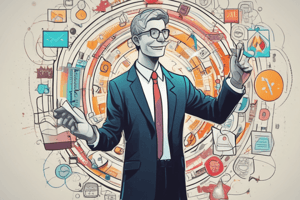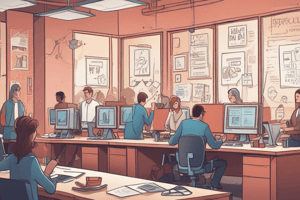Podcast
Questions and Answers
What is the primary focus of Herzberg's Two-Factor Theory?
What is the primary focus of Herzberg's Two-Factor Theory?
- Personal needs and environmental factors
- Distinction between hygiene factors and motivators (correct)
- Achievement and recognition
- Salary and work conditions
Which theory emphasizes the importance of autonomy, competence, and relatedness in motivation?
Which theory emphasizes the importance of autonomy, competence, and relatedness in motivation?
- Goal-Setting Theory
- Self-Determination Theory (correct)
- Equity Theory
- Expectancy Theory
In Tuckman's model, which stage involves establishing goals and getting acquainted?
In Tuckman's model, which stage involves establishing goals and getting acquainted?
- Performing
- Forming (correct)
- Storming
- Norming
What is the main difference between functional and dysfunctional conflict in teams?
What is the main difference between functional and dysfunctional conflict in teams?
Which job design approach focuses on increasing job variety?
Which job design approach focuses on increasing job variety?
Which component of expectancy theory evaluates the value of the outcome?
Which component of expectancy theory evaluates the value of the outcome?
Which of the following is NOT one of the stages in Tuckman's model of team development?
Which of the following is NOT one of the stages in Tuckman's model of team development?
What is a key application for maintaining motivation during a project?
What is a key application for maintaining motivation during a project?
Which conflict resolution technique focuses on finding a middle ground between opposing parties?
Which conflict resolution technique focuses on finding a middle ground between opposing parties?
What is a key difference between leadership and management?
What is a key difference between leadership and management?
Which leadership theory emphasizes building trust and supporting team members?
Which leadership theory emphasizes building trust and supporting team members?
In the Hersey-Blanchard Model of Situational Leadership, what determines the leader's style?
In the Hersey-Blanchard Model of Situational Leadership, what determines the leader's style?
Which type of leadership is characterized by routine exchanges and performance-related rewards?
Which type of leadership is characterized by routine exchanges and performance-related rewards?
What is a disadvantage of using lean communication channels?
What is a disadvantage of using lean communication channels?
What is a primary barrier to effective communication caused by different cultural backgrounds?
What is a primary barrier to effective communication caused by different cultural backgrounds?
Which of the following is a characteristic of servant leadership?
Which of the following is a characteristic of servant leadership?
Which component is NOT part of the communication process?
Which component is NOT part of the communication process?
What is a potential barrier to effective communication that involves cultural differences?
What is a potential barrier to effective communication that involves cultural differences?
According to Maslow's Hierarchy of Needs, which of the following best represents a need for self-actualization?
According to Maslow's Hierarchy of Needs, which of the following best represents a need for self-actualization?
Which of the following is an example of the storming stage in Tuckman's Model of team development?
Which of the following is an example of the storming stage in Tuckman's Model of team development?
What technique can improve communication by encouraging deeper engagement?
What technique can improve communication by encouraging deeper engagement?
If an employee feels demotivated due to noticing a pay disparity with a counterpart, which theory is primarily at play?
If an employee feels demotivated due to noticing a pay disparity with a counterpart, which theory is primarily at play?
In the context of goal-setting theory, what is crucial for motivating a team?
In the context of goal-setting theory, what is crucial for motivating a team?
Which of the following best describes the adjourning stage in Tuckman's Model?
Which of the following best describes the adjourning stage in Tuckman's Model?
What is a primary technique for active listening?
What is a primary technique for active listening?
Which of the following theories focuses on the underlying needs that motivate employees?
Which of the following theories focuses on the underlying needs that motivate employees?
What distinguishes teams from groups in a management context?
What distinguishes teams from groups in a management context?
Which leadership style emphasizes adapting to the context of a situation?
Which leadership style emphasizes adapting to the context of a situation?
What is an example of a self-motivation strategy?
What is an example of a self-motivation strategy?
Which type of team is characterized by individuals from various departments working together on a specific project?
Which type of team is characterized by individuals from various departments working together on a specific project?
What is a key difference between transformational and transactional leadership?
What is a key difference between transformational and transactional leadership?
Which of the following is a recommended approach for resolving conflicts constructively within teams?
Which of the following is a recommended approach for resolving conflicts constructively within teams?
What is a major characteristic of transactional leadership?
What is a major characteristic of transactional leadership?
How does situational leadership adapt to employee development?
How does situational leadership adapt to employee development?
What is an example of overcoming cross-cultural communication barriers?
What is an example of overcoming cross-cultural communication barriers?
Which leadership style would be exemplified by a CEO sharing a green vision for sustainability?
Which leadership style would be exemplified by a CEO sharing a green vision for sustainability?
In the communication process, what does 'noise' refer to?
In the communication process, what does 'noise' refer to?
Which of the following is a function of rich communication channels?
Which of the following is a function of rich communication channels?
What is a key aspect of ethical leadership?
What is a key aspect of ethical leadership?
What role does social media play in management communication?
What role does social media play in management communication?
Flashcards
Maslow's Hierarchy of Needs
Maslow's Hierarchy of Needs
A theory of motivation with a five-tier model of human needs, starting with basic physiological needs and progressing to self-actualization.
Herzberg's Two-Factor Theory
Herzberg's Two-Factor Theory
Work satisfaction and dissatisfaction are influenced by distinct factors: motivators (achievement, recognition) and hygiene factors (salary, working conditions).
Expectancy Theory
Expectancy Theory
Motivation depends on the effort put in, the belief that effort leads to performance (expectancy), belief that performance leads to a reward (instrumentality), and the value of the reward (valence).
Tuckman's Stages of Team Development
Tuckman's Stages of Team Development
Signup and view all the flashcards
Functional Conflict
Functional Conflict
Signup and view all the flashcards
Dysfunctional Conflict
Dysfunctional Conflict
Signup and view all the flashcards
Job Enrichment
Job Enrichment
Signup and view all the flashcards
Group vs. Team
Group vs. Team
Signup and view all the flashcards
Conflict Resolution Techniques
Conflict Resolution Techniques
Signup and view all the flashcards
Leadership vs. Management
Leadership vs. Management
Signup and view all the flashcards
Transactional Leadership
Transactional Leadership
Signup and view all the flashcards
Transformational Leadership
Transformational Leadership
Signup and view all the flashcards
Communication Rich Channels
Communication Rich Channels
Signup and view all the flashcards
Communication Barriers
Communication Barriers
Signup and view all the flashcards
Situational Leadership
Situational Leadership
Signup and view all the flashcards
Team Dysfunction Causes
Team Dysfunction Causes
Signup and view all the flashcards
Active Listening
Active Listening
Signup and view all the flashcards
Nonverbal Communication
Nonverbal Communication
Signup and view all the flashcards
Empathy
Empathy
Signup and view all the flashcards
What motivates employees?
What motivates employees?
Signup and view all the flashcards
Job Design
Job Design
Signup and view all the flashcards
Self-Motivation
Self-Motivation
Signup and view all the flashcards
Team vs. Group
Team vs. Group
Signup and view all the flashcards
Conflict Management
Conflict Management
Signup and view all the flashcards
Team Dysfunction Example
Team Dysfunction Example
Signup and view all the flashcards
Communication Process
Communication Process
Signup and view all the flashcards
Trait-Based Leadership Example
Trait-Based Leadership Example
Signup and view all the flashcards
Situational Leadership Example
Situational Leadership Example
Signup and view all the flashcards
Transactional vs. Transformational Leadership
Transactional vs. Transformational Leadership
Signup and view all the flashcards
Equity Theory
Equity Theory
Signup and view all the flashcards
Ethical Leadership Example
Ethical Leadership Example
Signup and view all the flashcards
Goal-Setting Theory
Goal-Setting Theory
Signup and view all the flashcards
Communication Process Noise
Communication Process Noise
Signup and view all the flashcards
Rich vs. Lean Channels
Rich vs. Lean Channels
Signup and view all the flashcards
Team Development Stages
Team Development Stages
Signup and view all the flashcards
Overcoming Cross-Cultural Barriers
Overcoming Cross-Cultural Barriers
Signup and view all the flashcards
Conflict Resolution
Conflict Resolution
Signup and view all the flashcards
Study Notes
Motivation Theories
- Content Theories: Maslow's Hierarchy of Needs emphasizes physiological, safety, love/belonging, esteem, and self-actualization needs. Herzberg's Two-Factor Theory differentiates motivators (e.g., achievement, recognition) from hygiene factors (e.g., salary, working conditions). Deci and Ryan's Self-Determination Theory highlights autonomy, competence, and relatedness.
- Process Theories: Equity Theory focuses on perceived fairness and how inequities influence motivation. Expectancy Theory suggests motivation depends on expectancy (effort to performance), instrumentality (performance to outcome), and valence (value of outcome). Goal-Setting Theory emphasizes that specific, challenging goals boost motivation and performance.
Job Design Approaches
- Traditional Approach: Simplifies jobs for efficiency.
- Modern Approaches: Job rotation expands variety, job enlargement increases responsibility, and job enrichment increases both variety and responsibility.
Behavior Modification and Rewards
- Reinforcement theory utilizes positive/negative reinforcement, punishment, and extinction. Compensation strategies include performance-based pay and intrinsic rewards.
Applications
- Use interim goals to track progress. Celebrate milestones to maintain motivation. Reframe reasons for goals to align with personal values.
Groups vs. Teams
- Groups: Individuals interacting to share norms and goals.
- Teams: Groups with collective performance, mutual accountability, and interdependence.
Stages of Team Development (Tuckman's Model)
- Forming: Members get acquainted and establish goals.
- Storming: Differences and conflicts emerge.
- Norming: Team norms are established and cohesion develops.
- Performing: Teams focus on achieving objectives.
- Adjourning: Disbandment after task completion.
Conflict Management
- Functional Conflict: Improves decision-making and innovation.
- Dysfunctional Conflict: Hinders performance.
- Techniques include avoiding, accommodating, forcing, compromising, and collaborating.
Team Dysfunction and Remedies
- Causes: Lack of trust, poor communication, unclear goals.
- Solutions: Establishing clear roles, norms, and constructive feedback channels.
Defining Leadership
- Leadership inspires others to achieve organizational goals, distinct from management's focus on tasks and processes.
- Trait Theories: Focus on inherent traits like charisma, intelligence, and decisiveness.
- Behavioral Theories:
- Task-oriented behaviors: Setting goals and clarifying roles.
- Relationship-oriented behaviors: Building trust and supporting team members.
- Situational Leadership: Leaders adapt their styles based on followers' readiness levels (directing, coaching, supporting, delegating).
- Transactional vs. Transformational Leadership: Transactional involves routine exchanges (rewards for meeting goals), while transformational inspires change through vision and influence.
Contemporary Perspectives
- Servant leadership: Prioritizes followers' needs and growth.
- Ethical leadership: Incorporates fairness and integrity.
Communication in Management
- Communication Process: Sender, encoding, message, channel, decoding, receiver, feedback, noise.
- Rich vs. Lean Channels: Rich channels (e.g., face-to-face) are suitable for complex messages; lean channels (e.g., email) for straightforward ones.
- Barriers to Communication: Physical, personal, cross-cultural, nonverbal, and gender differences.
Managing for Motivation
- Maslow's Hierarchy of Needs: Physiological, safety, love/belonging, esteem, self-actualization needs.
- Equity Theory: Employees compare their inputs and outputs to others' to assess fairness.
- Goal-Setting Theory: Specific, challenging goals motivate employees.
- Job Enrichment: Increases employee responsibility and ownership to boost motivation.
Managing Teams
- Key Concepts: Difference between groups and teams (Groups are management-directed, Teams are self-directed), Characteristics and types of teams (Project, cross-functional, self-managed, virtual), Conflict management (identify causes, frame conflicts around behaviors).
Studying That Suits You
Use AI to generate personalized quizzes and flashcards to suit your learning preferences.
Related Documents
Description
Explore key motivation theories including Maslow's Hierarchy of Needs and Herzberg's Two-Factor Theory. Additionally, learn about various job design approaches, from traditional efficiency models to modern methods such as job rotation and enrichment. This quiz will test your understanding of these essential concepts in organizational behavior.




